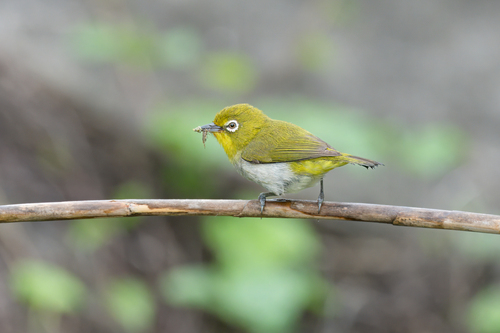
Warbling White-eye
The Warbling White-eye (*Zosterops japonicus*), also known as the Japanese White-eye, is a small, active songbird native to East Asia. It's easily recognizable by its distinctive white eye-ring and olive-green plumage. While originally found in Japan, Korea, eastern China, and Taiwan, it has been introduced to various other regions, including Hawaii, where it has become both a popular and sometimes problematic species. Ecologically, the Warbling White-eye plays a role in pollination and seed dispersal, but its adaptability has also led to competition with native bird species in introduced areas. It holds no particular cultural significance beyond being a common and appreciated songbird.
10-12 cm
Length
16-20 cm
Wingspan
Least Concern
Conservation Status
Distribution
Native to East Asia, including Japan, South Korea, eastern China, Taiwan, and parts of Southeast Asia (e.g., Vietnam, Philippines). Introduced and established in Hawaii, parts of North America (California), and Réunion Island. It is generally non-migratory but may make altitudinal movements in some regions.
Lifespan
Average lifespan in the wild is not well-documented but is estimated to be around 3-5 years. Longer lifespans are possible in captivity.
Warbling White-eye's Habitat
Habitat Types
Forests (broadleaf, mixed, and coniferous), Woodlands, Shrublands, Gardens, Parks, Orchards, Urban areas
Climate Zones
Temperate, Subtropical, Tropical (in introduced ranges)
Adaptations
The Warbling White-eye is highly adaptable to a range of habitats, from natural forests to human-modified environments. Its small size and agile flight allow it to forage effectively in dense vegetation. Its generalist diet also contributes to its adaptability.
Variations
Several subspecies are recognized, including *Z. j. japonicus* (Japan), *Z. j. simplex* (eastern China and Taiwan), and *Z. j. alani* (Iwo Jima). These subspecies differ slightly in plumage coloration and size.
Appearance
Breeding Plumage
Plumage is generally consistent year-round, with no significant differences between breeding and non-breeding seasons.
Seasonal Feather Changes
No significant seasonal changes.
Sex Based Plumage Differences
Males and females have very similar plumage. Slight variations in brightness may exist but are difficult to discern without close examination.
Notable Features
Prominent white eye-ring, Olive-green upperparts, Yellowish throat and undertail coverts, Pale greyish-white belly, Short, pointed bill
Diet and Feeding
Primary Foods
Insects, Spiders, Nectar, Small fruits, Berries, Seeds
Foraging Behavior
Warbling White-eyes are active foragers, often seen flitting through foliage in search of insects and other small invertebrates. They also glean insects from leaves and branches. They frequently visit flowers to feed on nectar and will consume a variety of fruits and berries, especially during the non-breeding season.
Specializations
They possess a brush-tipped tongue, which is an adaptation for extracting nectar from flowers. Their small, pointed bill is well-suited for capturing insects.
Seasonal Diet Variations
Diet shifts seasonally depending on food availability. Insects and spiders are more prominent in the diet during the breeding season, while fruits, berries, and nectar become more important during the non-breeding season.
Behavior
Social Structure
Warbling White-eyes are highly social birds, often forming small flocks, especially outside of the breeding season. During the breeding season, they may defend small territories around their nests.
Communication
Variety of calls, including a high-pitched 'tsee' contact call., A warbling song, often described as sweet and melodious., Visual displays, such as wing-fluttering during courtship.
Migration
Mostly non-migratory, but some populations may undertake short-distance altitudinal movements in response to food availability or weather conditions.
Territorial or Group Behaviors
During the breeding season, pairs may defend small territories around their nests. Outside of the breeding season, they form flocks that forage and roost together. These flocks can range in size from a few individuals to dozens of birds.
Conservation
Threats
Habitat loss (in some parts of its range), Competition with native species (in introduced areas), Predation by introduced predators (e.g., rats, cats, mongoose in Hawaii), Pesticide use
Protection Programs
None specifically targeted at Warbling White-eyes due to their 'Least Concern' status. However, general habitat conservation efforts benefit this species.
Local National Laws
Protected under general bird protection laws in many countries, such as the Migratory Bird Treaty Act in the United States (even though it's not migratory in many areas where it's found).
Population Trend
Stable
Population Estimates
Globally, the population is considered large and not currently threatened. Specific population estimates are difficult to obtain due to its wide distribution and adaptability.
Interesting Facts
They are known to hybridize with other white-eye species.
This has been observed in areas where their ranges overlap, leading to genetic mixing.
In Hawaii, they are sometimes considered a pest.
Due to their competition with native Hawaiian honeycreepers for nectar and insects, and their role in spreading invasive plant seeds.
They are efficient pollinators of some plant species.
Their brush-tipped tongue and frequent visits to flowers make them effective pollinators, although they can also damage flowers while foraging.
They are sometimes called "Mejiro" in Japanese.
Mejiro (目白) literally translates to "white eye".
Faqs about Warbling White-eye
Are Warbling White-eyes good pets?
While they are small and attractive, keeping wild birds as pets is generally discouraged and often illegal. They are best appreciated in their natural environment.
How can I attract Warbling White-eyes to my garden?
Providing a variety of flowering plants, fruit-bearing trees, and a source of fresh water can attract them. Avoid using pesticides, which can harm them directly or reduce their food supply.
Do Warbling White-eyes migrate?
Most populations are non-migratory, but some may make short-distance movements in response to food availability or weather.
What should I do if I find an injured Warbling White-eye?
Contact a local wildlife rehabilitator or veterinarian for advice. It is illegal to possess or care for wild birds without the proper permits.
Copyright @ Nature Style Limited. All Rights Reserved.
 English
English